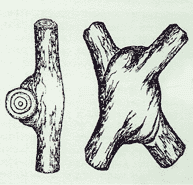Arthur Wiechula
Arthur Wiechula (January 20, 1867 – 1941) was a German landscape engineer. His marriage to Lydia Lindnau, produced three children, Margarethe (1895), Max (1897) and Ernst (1900).[1]

He received the German Royal State Inventor's Honor Cross. In 1926, he published Wachsende Häuser aus lebenden Bäumen entstehend [2] (Developing Houses from Living Trees) in German,[3][4] describing simple building techniques involving guided grafting together of live branches; including a system of v-shaped lateral cuts used to bend and curve individual trunks and branches in the direction of a design, with reaction wood soon closing the wounds to hold the curve.[3]
He envisioned growing trees so that it constituted walls during growth, thereby enabling the use of young trees for building.[3] He never built a living home, but he grew a 394-foot (120 m) wall of Canadian poplars to help keep the snow off of a section of train tracks.[4] His illustrated ideas have inspired many other artists to attempt to grow living homes out of trees.
See also
- Tree Shaping
- Topiary
- Espalier
- Pleaching
- Bonsai
- John Krubsack
- Axel Erlandson
- Dr Christopher Cattle
- Richard Reames
- Fab Tree Hab: Living Home of Shaped Trees
- Gilroy Gardens: Home of the Circus Trees
- Full Grown
References
- Kirsch, Konstantin (1996), Naturbauten aus lebenden Geholzen (Nature House Building) (3 ed.), OLV, Organischer Landbau-Verl. Lau, p. 82, ISBN 978-3-922201-17-5
- Wiechula, Arthur (1926), Wachsende Häuser aus lebenden Bäumen entstehend (Developing Houses from Living Trees), Verl. Naturbau-Ges, p. 320
- "designboom: history of arborsculpture".
- Link, Tracey (June 13, 2008), Arborsculpture: An Emerging Art Form and Solutions to our Environment (PDF), Senior project for Bachelor of Science degree in Landscape Architecture, p. 15, archived from the original (PDF) on February 25, 2012, retrieved May 16, 2010